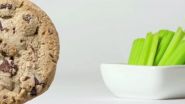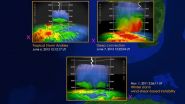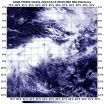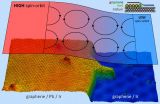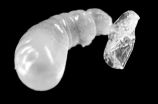(Press-News.org) "Most researchers have treated the order in which the information is shown as a nuisance that can bias the interpretation of data," said Ting Qian, lead author and a former graduate student in brain and cognitive sciences at the University of Rochester. But as Qian's co-author and thesis advisor, Professor Richard Aslin explained, "We see it as a part of the natural statistics of the real world, and therefore a signal--or cue--that can be the basis of rational decisions."
In a paper published in the journal Proceedings of the National Academy of Sciences, Qian and Aslin have explained that our tendency to detect patterns in data is built into our cognitive processes, even when it's at the risk of overestimating the importance of such patterns.
When a coin is flipped, it rarely alternates between heads and tails over a large number of flips. Instead, there will be multiples of one, then the other.
"If we get an unusually high multiple--maybe five or six heads--someone could easily assume it's an unfair coin," said Aslin. "But if the coin is normal, and if the person waits long enough, the number of heads and tails would pretty much even out."
Qian and Aslin explain that even when patterns do not lead to correct conclusions--as , as in the case of assuming a standard coin has been modified in a way to come up heads more times than not--the patterns provide information that point to possibilities that might not have been considered otherwise.
For example, if there were several coins being flipped, and an observer knew that one of the coins was biased, an unusually large number of consecutive heads might be a cue that the one coin is unfair.
"If we could wait forever in any given situation, we'd have all the information we need to reach a fair conclusion," said Aslin. "But in the real world, we need to make decisions more quickly. And that involves working with bundles of data that convey, what looks like, consistent information--such as a coin coming up heads four straight times."
In their work, the two researchers began by replicating the classic "hot hand" in basketball study conducted by Amos Tversky and Thomas Gilovich (1985) to see how people interpreted players' performances based on their shooting statistics. Qian and Aslin showed 100 subjects six different sequences of data presented in bundles--3 hits, 3 misses, 3 hits, 3 misses--and asked them whether the performances could be classified as "streak shooting." Qian and Aslin's results were in agreement with the original study. While the data showed players making about 50 percent of their shots during a game, 90 percent of the subjects perceived streak shooting, even though the streaks were too small to support the notion that any player had a "hot hand."
Tversky and colleagues interpreted the perception of streak shooting under these circumstances as irrational because the overall evidence indicates the shooters have a roughly 50 percent success rate, and the short bundles of made and missed shots are typical of what is found in situations with two recurring possibilities. In contrast, Qian and Aslin argued that the tendency to see streaks is an inevitable result of the brain's programming to use order as a cue to hidden structures in sequential data.
"We proposed that this perception of streaks is not because of a failure to understand what probability is," said Aslin. "It's actually due to the natural tendency of the human mind to seek patterns."
Sometimes the streaks are real, of course.
When deciding which players to use at the end of a close game, a coach may consider a player's consecutive hits or misses. "If a player has missed four straight attempts, it may lead the coach to ask whether the player has an injury," said Qian. "That's a possibility that might not have occurred to the coach, if not for the pattern of several consecutive misses."
Qian and Aslin developed a rational computational model to explain how people infer such hidden structures in sequential data, which they refer to as "bundles." They call it the Hibachi grill process (HGP) mixture model, named for a popular Japanese-style dining experience. Imagine a restaurant at which one entrée is the primary offering at each table and customers are seated based on their meal preferences. The owner is trying to maximize customer satisfaction and staff efficiency by having customers sit at the tables of their preferred dishes. The HGP mixture model extends the metaphor to include the assumption that restaurant customers typically arrive as groups of friends who have similar tastes and would want to sit at the same table. The model uses mathematical computations in an attempt to identify those hidden groups of friends from a stream of customers by relying on the stimulus order--that is, the order in which the customers enter the restaurant. The additional feature--that different groups of friends may share the same table--gives the model its name - a resemblance to the typical seating arrangement in many Hibachi grill restaurants in the US.
However, Qian and Aslin said, the HGP mixture model is a description of the mathematical underpinnings involving cognitive processes, and does not necessarily reflect on the "rationality" of the conclusions drawn from data.
It is unclear whether people should discover bundles from order in every situation. The Ebola crisis offers a real-world scenario. "If, for example, a person heard about three consecutive patients at a medical clinic who were diagnosed with the Ebola virus, he or she might suspect a community-wide epidemic," said Aslin. But, it's possible that the information conveyed by the patient order was not meaningful. It may be that the three patients were from the same household and contracted the disease because they were living together.
Qian and Aslin said that the HGP model reveals not what the world really is, but what our mind interprets it to be, assuming a crucial role for the order of information.
INFORMATION:
VIDEO:
Caltech neuroeconomists have found that your ability to exercise self-control when deciding what to eat may depend upon just how quickly your brain factors healthfulness into a decision.
Click here for more information.
When you open the refrigerator for a late-night snack, are you more likely to grab a slice of chocolate cake or a bag of carrot sticks? Your ability to exercise self-control--i.e., to settle for the carrots--may depend upon just how quickly your brain factors ...
LANSING, Mich. December 15, 2014 - Cyclists who are preparing for race day may have a new sports drink to give them an edge in recovery: tart cherry juice. A new study published in Applied Physiology, Nutrition, and Metabolism found that Montmorency tart cherry juice helped accelerate recovery, maintain muscle function and reduce certain markers of exercise-induced inflammation among a group of cyclists participating in a simulated road race.
The research team, led by Glyn Howatson and Phillip G. Bell at Northumbria University in the U.K., conducted this double-blind, ...
Each day, thunderstorms around the world produce about a thousand quick bursts of gamma rays, some of the highest-energy light naturally found on Earth. By merging records of events seen by NASA's Fermi Gamma-ray Space Telescope with data from ground-based radar and lightning detectors, scientists have completed the most detailed analysis to date of the types of thunderstorms involved.
"Remarkably, we have found that any thunderstorm can produce gamma rays, even those that appear to be so weak a meteorologist wouldn't look twice at them," said Themis Chronis, who led ...
WASHINGTON, Dec. 15, 2014 -- It's something your mother told you time and time again at the dinner table: "Eat your carrots, they'll help you see better!" So was she right? This week, Reactions answers the question with the help of chemist Chad Jones, Ph.D., host of the award-winning Collapsed Wave Function podcast. Check out the video here: https://www.youtube.com/watch?v=w3DNScZYvYY.
Subscribe to the series at Reactions YouTube, and follow us on Twitter @ACSreactions to be the first to see our latest videos.
INFORMATION:The American Chemical Society is a nonprofit ...
Online content creation has become easier than ever and is quickly reaching parity with content consumption. From writing a blog or social media post to letting an app turn your photos into a video montage, anyone with an Internet connection can publish these creations with the click of a button.
But in the age of Web publishing, it has become increasingly confusing for content creators to figure out how to protect their original works or to use other content legally -- such as for remixes or parodies -- on major websites for user-generated content, including YouTube ...
New York (15 December 2014)--A study published today is the first detailed assessment of whether the 8-year Iraq War had an effect on childbearing. The study found that before the war, from 1997 to 2003, adolescent fertility in Iraq was stable at just below 70 births per 1,000 girls aged 15-19. However, soon after the beginning of the war, adolescent fertility rose by more than 30 percent, reaching over 95 births per 1,000 girls in 2010. The study is included in the December 2014 issue of Population and Development Review, a peer-reviewed journal published by the Population ...
Tropical Cyclone Bakung ran into adverse conditions in the Southern Indian Ocean that weakened it to a remnant low pressure system when NASA's Aqua satellite spotted it on Dec. 15.
The Moderate Resolution Imaging Spectroradiometer or MODIS instrument that flies aboard Aqua captured a visible picture of Bakung's elongated remnants on Dec. 5 at 08:05 UTC (3:05 a.m. EST). The storm appeared to be stretched out from west to east in the visible image.
The last advisory on the tropical cyclone came on Dec. 13 when the storm was still a tropical storm with maximum sustained ...
WASHINGTON (Dec. 15, 2014)--Over prescription of antibiotics is a major factor driving one of the biggest public health concerns today: antibiotic resistance. In a first-of-its-kind study, research led by the George Washington University suggests that public health educational materials may not address the misconceptions that shape why patients expect antibiotics, driving doctors to prescribe them more. The research appeared in October in the journal Medical Decision Making.
Researchers from George Washington, Cornell and Johns Hopkins universities surveyed 113 patients ...
Researchers in Spain have discovered that if lead atoms are intercalated on a graphene sheet, a powerful magnetic field is generated by the interaction of the electrons' spin with their orbital movement. This property could have implications in spintronics, an emerging technology promoted by the European Union to create advanced computational systems.
Graphene is considered the material of the future due to its extraordinary optical and electronic mechanical properties, especially because it conducts electrons very quickly. However, it does not have magnetic properties, ...
To the casual observer, the colonies of social insects like bees and ants appear to be harmonious societies where individuals work together for the common good. But appearances can be deceiving.
In fact, individuals within nests compete over crucial determinants of fitness such as reproductive dominance and production of male eggs. The intensity of competition often depends on the level of kinship between colony members. This is because selfish individuals lose indirect fitness when their behavior harms close relatives. A new study by Eva Schultner and colleagues from ...
